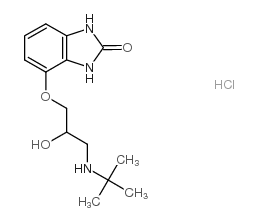CGP 12177 hydrochloride

CGP 12177 hydrochloride structure
|
Common Name | CGP 12177 hydrochloride | ||
|---|---|---|---|---|
| CAS Number | 64208-32-8 | Molecular Weight | 315.80 | |
| Density | N/A | Boiling Point | N/A | |
| Molecular Formula | C14H22ClN3O3 | Melting Point | N/A | |
| MSDS | USA | Flash Point | N/A | |
|
ALpha1-adrenoceptor antagonist properties of CGP 12177A and other beta-adrenoceptor ligands: evidence against beta(3)- or atypical beta-adrenoceptors in rat aorta.
Br. J. Pharmacol. 142 , 781-787, (2004) 1. The alpha(1)-adrenoceptor antagonist properties of the beta-adrenoceptor nonconventional partial agonist, CGP 12177A, was investigated in functional assays in rat aorta and in radioligand binding assays in rat cerebral cortical membranes. In addition, bind... |
|
|
Contribution of beta-adrenoceptor subtypes to relaxation of colon and oesophagus and pacemaker activity of ureter in wildtype and beta(3)-adrenoceptor knockout mice.
Br. J. Pharmacol. 130 , 747-758, (2000) The smooth muscle relaxant responses to the mixed beta(3)-, putative beta(4)-adrenoceptor agonist, (-)-CGP 12177 in rat colon are partially resistant to blockade by the beta(3)-adrenoceptor antagonist SR59230A suggesting involvement of beta(3)- and putative b... |
|
|
The effects of beta-adrenoceptor agonists on KCl-induced rhythmic contraction in the ureter of guinea pig.
J. Smooth Muscle Res. 36 , 13-19, (2000) In the present study, we tried to determine what effects were induced by beta-adrenoceptor agonists on 40 mM KCl-induced rhythmic contraction and to clarify which beta-adrenoceptor subtypes are involved in the regulation of ureter motility in the guinea pig b... |
|
|
In vivo effects of CGP-12177 on the expression of leptin and uncoupling protein genes in mouse brown and white adipose tissues.
Int. J. Obes. 24 , 423-428, (2000) To assess the effect of chronic treatment with CGP-12177 a beta3-adrenergic receptor (AR) agonist with beta2/beta1-AR antagonist action, on the expression of the leptin gene and of genes coding for uncoupling proteins (ucp1, ucp2 and ucp3) in brown and white ... |
|
|
Oleoylethanolamide enhances β-adrenergic-mediated thermogenesis and white-to-brown adipocyte phenotype in epididymal white adipose tissue in rat.
Dis. Model Mech. 7 , 129-41, (2014) β-adrenergic receptor activation promotes brown adipose tissue (BAT) β-oxidation and thermogenesis by burning fatty acids during uncoupling respiration. Oleoylethanolamide (OEA) can inhibit feeding and stimulate lipolysis by activating peroxisome proliferator... |